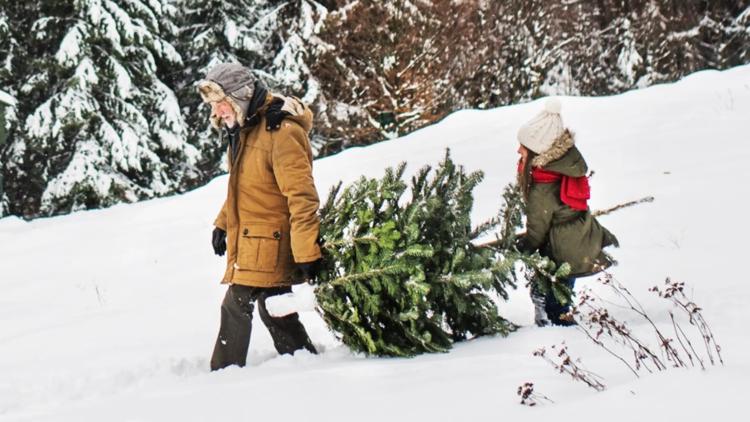CADILLAC, Michigan — As we head towards December, Christmas tree lots will begin to appear on corners and along busy roads.
In the midst of the hustle and bustle of the holiday season, trees wrapped in netting and ready to go won't be hard to come by.
But for those who prefer the old-fashioned way, the Huron-Manistee National Forests are chock-full of the perfect trees for you and your family.
The Permit
In order to cut down your own Christmas tree, you need to purchase a permit here.
To complete the online transaction, visitors will need to create, or log in, to an account.
Permits can also be purchased in person from HMNF's district offices between 9 a.m. and 4 p.m. Monday through Friday, except for federal holidays.
One Christmas tree can be harvested per permit. Permits cost $5 each and are limited to five permits per person, per season.
Those with an Every Kid Outdoors pass/voucher are eligible for a free Christmas tree permit by checking the box that states you have a pass, then entering the pass or voucher number.
You must have your permit with you when you cut down your tree, and each tree must be tagged before you transport it.
The Time Frame
HMNF said it's important to try to wait for a few hard frosts and consistently cold days before cutting down your Christmas tree.
This guarantees that the evergreen species will have fallen into a state of hardened dormancy for winter. When this happens, the trees' needles will form a heavy, waxy coating called cutin to prevent moisture loss, so your tree is less likely to react to sun and warm indoor temperatures.
Tree permits are valid through Dec. 31, 2024.
Where to cut the tree
- Don't cut within private land, in wilderness areas, experimental forests, research natural areas, recreation residence tracts, or existing tree plantations
- Don't cut within active timber sales or areas that have been planted with new trees
- Maps of approved cutting areas are downloadable here
- Don't cut trees within 100 feet of water bodies, campgrounds, picnic areas, trailheads or other developed recreation areas
- Don't cut trees within 100 feet of paved roads and 50 feet from dirt roads
- Motorized vehicles are only allowed on existing roads and trails authorized for motorized use
- These are indicated on the Motor Vehicle Use Map
- No off-road travel is allowed
- Observe seasonal road closures and be prepared to hike to the cutting area to find a tree
How to choose the tree
- Harvest trees only on National Forest System lands that are open for cutting (See fuelwood maps
- Don't cut cedar or hemlock trees. Only cut conifers.
- All stumps must be cut within 6 inches of the ground
- The maximum height of trees allowed for cutting is 20 feet and maximum diameter is 6 inches
- Take the whole tree. Do not remove the top of the tree; cut down the entire tree.
- If snow is on the ground, remove it from around the stump so you can accurately measure the stump and tree height
- Attach a valid Christmas tree tag to each tree before removing it from the site at which it was cut.
- Keep the tag attached to trees in transit
Supplies you'll need
- A handsaw or similar instrument to cut your tree
- Pruning shears to trim low-hanging branches near the tree’s stump
- Rope or cables to secure the tree to your vehicle
- Food and water
What you'll wear
You should wear warm, waterproof clothes when you embark on the journey to cut down your Christmas tree.
As hunting is a part of fall recreation in the forest, you may run into hunters in the woods.
You should wear blaze orange and be highly visible so hunters can see you. If you bring your pet, they should be on a leash and wearing blaze orange so they aren't mistaken for prey.
The trip
HMNF recommends planning for the trip to take several hours altogether.
Officials said it's important to tell a friend or neighbor where you're going and when you'll be back.
Visitors should prepare for unplowed forest roads. There will be spotty cellular reception at best, and visitors should be sure their phone battery is charged.
Back at home
Once your Christmas tree is home, you should make a clean, straight cut across the trunk. It'll take three to four hours for the tree to heal over with dried sap.
The first cut made to get the tree home allows air to get into the plant tissues and disrupts the tree's ability to absorb water. When you cut the tree once more at home, it helps prep it to hydrate properly.
The tree should then be placed in a bucket of fresh water and kept in a cold environment like a garage or a porch.
The tree needs to stay well hydrated within the first 24 hours, as it can absorb as much as a gallon of water during this time.
Once the tree is moved inside, warmer environments can trigger it to take up more water and begin to grow. It's recommended to consider lowering the thermostat and put the tree in a less sunny location.
At least two inches of the trunk should be in water at all times to prevent sap from forming over the base.



